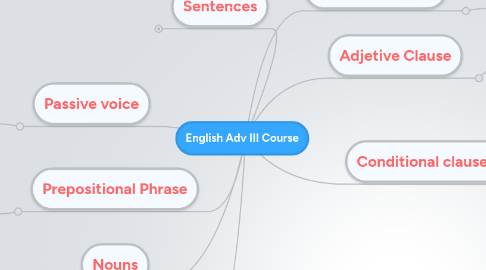
1. Sentences
1.1. Simple
1.1.1. also called an independent clause, contains a subject and a verb, and it expresses a complete thought.
1.1.1.1. Example
1.2. Compund
1.2.1. A compound sentence contains two independent clauses joined by a coordinator. The coordinators are as follows: for, and, nor, but, or, yet, so.
1.2.1.1. Example
1.3. Complex
1.3.1. has an independent clause joined by one or more dependent clauses. A complex sentence always has a subordinator such as because, since, after, although, or when or a relative pronoun such as that, who, or which.
1.3.1.1. Example
2. Passive voice
2.1. Passive voice is used when the focus is on the action. It is not important or not known, however, who or what is performing the action.
2.1.1. Example
2.1.1.1. My bike was stolen.
2.1.1.2. A mistake was made by me.
3. Prepositional Phrase
3.1. how the relation of one word to another word. Prepositions require an object to complete them, typically a noun or a pronoun. A preposition and its object is called a prepositional phrase.
3.1.1. IN
3.1.1.1. in a line, in a row, in a field, in a park, in a garden, in a room, in a city, in the lake, in the water, in the ocean, in an arm chair, in a mirror, in a photo & in the sky.
3.1.2. ON
3.1.2.1. On the floor, on the glass, on the chair, on the notice board, on the middle shelf, on the 2nd floor, on the way, on a lake, on a river, on an island & on the coast.
3.1.3. AT
3.1.3.1. At the desk, at the window, at the door, at the train station & at the bus stop.
4. Nouns
4.1. a word used to name a person, animal, place, thing, and abstract idea.
4.1.1. Countable
4.1.1.1. Plural
4.1.1.2. Singular
4.1.2. Non count
4.1.2.1. Concrete
4.1.2.1.1. Air, water, coffee, rice & sugar.
4.1.2.2. Abstract
4.1.2.2.1. Physics, economics, honesty & health.
5. New node
6. Parallel structure
6.1. Simply refers to similar grammatical forms. The forms can be words, phrases, clauses, or even sentences.
6.1.1. Example
6.1.1.1. PARALLEL With the -ing form (gerund) of words: Mary likes hiking, swimming, and bicycling. With infinitive phrases: Mary likes to hike, to swim, and to ride a bicycle.
6.1.1.2. NOT PARALLEL Mary likes hiking, swimming, and to ride a bicycle.
7. Adjetive Clause
7.1. dependent clause that modifies a noun.
7.1.1. Example
7.1.1.1. The children who are on the bus are going to visit the museum. | adjective clause |
8. Conditional clauses
8.1. they are used to express that the action in the main clause (without if) can only take place if a certain condition (in the clause with if) is fulfilled.
8.1.1. Types
8.1.1.1. Conditional Sentence Type 1 → It is possible and also very likely that the condition will be fulfilled. Form: if + Simple Present, will-Future Example: If I find her address, I’ll send her an invitation.
8.1.1.2. Conditional Sentence Type 2 → It is possible but very unlikely, that the condition will be fulfilled. Form: if + Simple Past, Conditional I (= would + Infinitive) Example: If I found her address, I would send her an invitation.
8.1.1.3. Conditional Sentence Type 3 → It is impossible that the condition will be fulfilled because it refers to the past. Form: if + Past Perfect, Conditional II (= would + have + Past Participle) Example: If I had found her address, I would have sent her an invitation.
